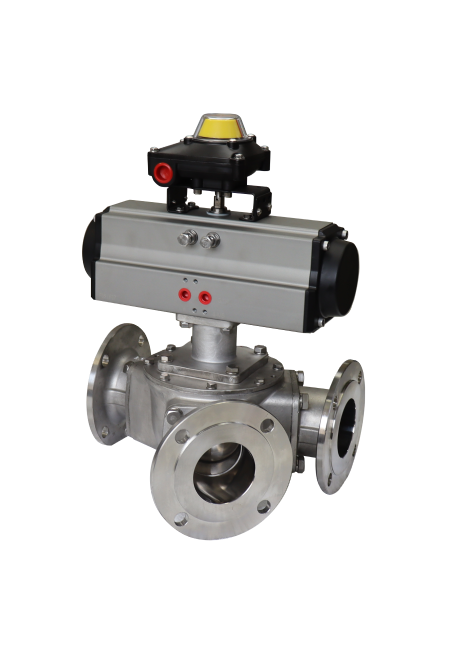Pneumatic Diverter Valves
Diverter Valve Functionality
A diverter valve works by diverting material flow, ensuring a smooth and regulated transition. These valves are essential in pneumatic conveying systems for directing powders, granules, or other materials via pipelines.
Working Process of Pneumatic Diverter Valves
A pneumatic diverter valve has an inlet, an outlet, and a mechanism (such as a rotating disc or a sliding gate) that can be adjusted to direct the powder to the desired outlet. When the valve is activated, it changes the direction of the powder flow, allowing it to be carried to a different location or process within the handling system. This helps in controlling powdered material distribution, which is required in a variety of industrial applications.

Significance in Industrial Settings
In Industrial settings, efficient material flow management is crucial. Diverter valves are a dependable solution for optimizing operations, reducing downtime, and improving overall operational efficiency. Pneumatic variants provide quick response and accurate control, making them excellent for applications requiring precision.
Features
- Sealing prevents leaks and maintains material integrity.
- Multiple ports integrate into complex transfer systems.
- Easy maintenance minimizes downtime, replaceable parts.
- Engineered for high temperature and pressure resistance.
- Corrosion-resistant coatings suitable for handling corrosive materials.
- Precision ensures accurate and controlled redirection.

Significance in Industrial Settings
In Industrial settings, efficient material flow management is crucial. Diverter valves are a dependable solution for optimizing operations, reducing downtime, and improving overall operational efficiency. Pneumatic variants provide quick response and accurate control, making them excellent for applications requiring precision.
Features
- Sealing prevents leaks and maintains material integrity.
- Multiple ports integrate into complex transfer systems.
- Easy maintenance minimizes downtime, replaceable parts.
- Engineered for high temperature and pressure resistance.
- Corrosion-resistant coatings suitable for handling corrosive materials.
- Precision ensures accurate and controlled redirection.



Applications
Whether directing materials in pneumatic conveying systems or managing substance flow in various processes, pneumatic diverter valve plays a vital role in ensuring smooth and controlled movement of materials.
Food items , Chemicals , Battery material and others
F.A.Q.
Have any Question?
A diverter valve is a mechanical device used to redirect the flow of material or substances in a pipeline. It typically consists of a valve body and an actuator that can switch between different flow paths.
Pneumatic diverter valves find applications in industries like food processing, pharmaceuticals, and chemical manufacturing, where the accurate and contamination-free transfer of materials is essential.
Rotary diverter valves are often installed in pneumatic conveying systems, bulk material handling, and industries such as chemical processing, and mining, where reliable material diversion is crucial.
Diverter valves are available in sizes ranging from 40mm to 250mm, offering flexibility to meet various conveying system requirements.
Yes, there are diverter valves designed with sanitary features, such as polished surfaces and FDA-approved seals, for use in hygienic processes.
In the chemical industry, diverter valves are essential for managing the flow of chemicals between various reactors, storage tanks, and processing units to ensure efficient production and minimize contamination risks.
